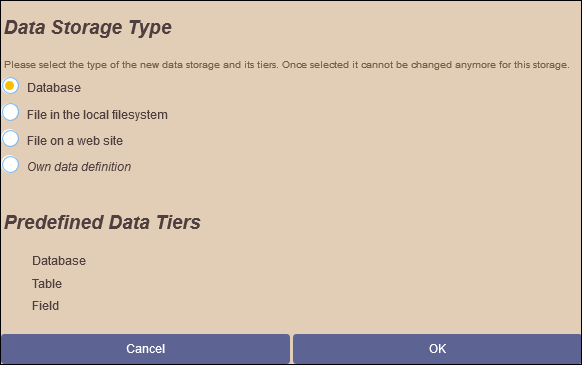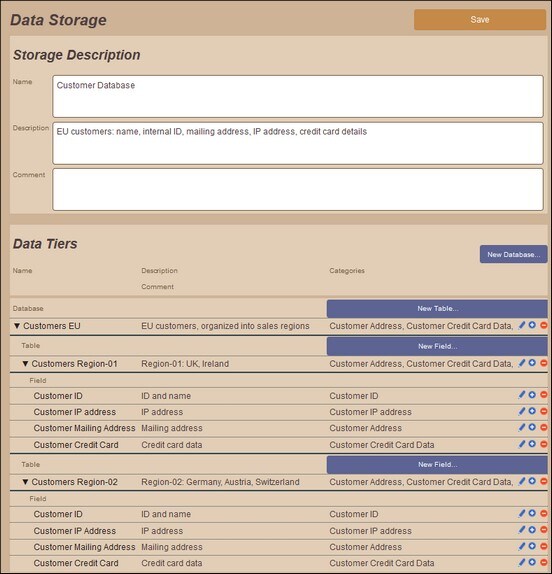Define Data Storage Entities
The Data Storage List page (screenshot below) is accessed from the Overview page. It lists the data storage entities that have been defined in the compliance database. Each data storage entity refers to a physical storage location where data belonging to one or more data categories is stored. The definition of the data storage entity expresses the relationship between the physical storage location and data categories. For example, if customer addresses are stored in a database, then the data storage location can be linked to the data category for customer addresses. This enables the physical locations of different data categories to be quickly looked up.
On the Data Storage List page you can add a new data storage entity (click New Data Storage; see screenshot below), edit details of existing data storage entities (click the Edit icon of a data storage entity), and delete existing data storage entities (click the Delete icon of a data storage entity).

Add a new data storage entity
When you add a new data storage entity (by clicking New Data Storage), a window appears asking you to specify the type of data storage that you want to define (screenshot below).

Select the type of the data storage entity. The data tiers for each data storage type are predefined.
•Database: The data tiers of a Database type are: Database, Table, and Field. For each Database storage type, you can enter multiple Database tiers. For each Database tier, you can enter multiple Table tiers. And for each Table tier, you can enter multiple Field tiers. Each tier can be associated with a data category, which indicates what kind of data is stored in that tier. See the screenshot below for an example of how database tiers are used.
•File in the local filesystem: The data tier is the file path of the data storage entity. Multiple file paths can be assigned, with each file path being associated with a data category, indicating what kind of data is stored at that file path location. Enter the file path in the Name field of the tier.
•File on a website: The data tier is the URL of the data storage entity. Multiple URLs can be assigned, with each URL being associated with a data category, indicating what kind of data is stored at that URL location.
•Own data definition: The number and type of data tier can be freely specified. Click New Tier to specify a new tier and add a descriptive phrase as the name of the tier.
After the data storage type is selected, click OK. The data storage entity is created (see screenshot below).
Add a name for the data storage entity, and optionally a description and comment. In the Data Tiers section, specify the data tiers. This could be a file path, or a URL, database, table or field. For each data tier you can associate a data category, which indicates for what data category that data tier is being used.
After you finish entering the details of the data storage entity, click Save to save the data storage entity to the compliance database.
Relationships with other metadata
A data storage entity has the following relationships with other metadata:
It selects... | Which sets up... |
The data category of each data tier of a storage entity. |
